Projections of Extreme Precipitation Changes over the Eastern Tibetan Plateau: Exploring Thermodynamic and Dynamic Contributions
Abstract
1. Introduction
2. Materials and Methods
2.1. Observational Data
2.2. Model Data
2.3. Extreme Precipitation Indices
2.4. Extreme Precipitation Indices
2.5. Physical Scaling Diagnostic
3. Results
3.1. Model Performance
3.2. Projection of Extreme Precipitation
3.3. Thermodynamic and Dynamic Contributions
4. Discussion
- (1)
- Both the LR and HR models effectively capture the spatial distribution of precipitation, with a noticeable increase in precipitation over the Hengduan Mountains and the eastern Tibetan Plateau, and a reduction in the Sichuan Basin. However, the models exhibit wet biases along the eastern edge of the Tibetan Plateau and in the Hengduan Mountains, alongside dry biases in the Sichuan Basin. Notably, the area-averaged absolute bias for the MME decreases from 1.09 mm/day in the LR models to 1.00 mm/day in the HR models, highlighting an improvement in the simulation of precipitation patterns in the ETP by the HR models.
- (2)
- The majority of extreme precipitation indices over the Eastern Tibetan Plateau show an upward trend, with the exception of CWD, which demonstrates a decline. By the mid-21st century, both HR and LR models forecast an intensification of short-duration heavy precipitation events. Projections also indicate a significant rise in both the frequency and intensity of extreme precipitation in the Sichuan Basin, with these changes being more pronounced in HR models than in LR models.
- (3)
- The changes in extreme precipitation over the eastern Tibetan Plateau are primarily driven by dynamic scaling, which governs the regional variations, particularly in the Sichuan Basin. The thermodynamic component plays a lesser role, being predominantly influenced by saturation specific humidity. Multi-Model Ensemble (MME) results reveal that dynamic scaling contributes 85% of the total change in HR models and 89% in LR models. Anticipated changes in vertical wind speed are expected to strengthen the hydrological cycle, exerting a profound impact on the patterns of extreme precipitation.
5. Conclusions
Author Contributions
Funding
Institutional Review Board Statement
Informed Consent Statement
Data Availability Statement
Acknowledgments
Conflicts of Interest
References
- Zhou, Z.; Zhang, L.; Zhang, Q.; Cao, H.; Zhang, H.; Jia, B.; Liu, L.; Tang, Z.; Chen, J. Amplified temperature sensitivity of extreme precipitation events following heat stress. npj Clim. Atmos. Sci. 2024, 7, 243. [Google Scholar] [CrossRef]
- Myhre, G.; Alterskjær, K.; Stjern, C.W.; Hodnebrog, Ø.; Marelle, L.; Samset, B.H.; Sillmann, J.; Schaller, N.; Fischer, E.; Schulz, M.; et al. Frequency of extreme precipitation increases extensively with event rareness under global warming. Sci. Rep. 2019, 9, 16063. [Google Scholar] [CrossRef] [PubMed]
- Lang, Q.; Wan, Z.; Zhang, J.; Zhang, Y.; Zhu, D.; Liu, G. Resilience Assessment and Enhancement Strategies for Urban Transportation Infrastructure to Cope with Extreme Rainfalls. Sustainability 2024, 16, 4780. [Google Scholar] [CrossRef]
- Hamisi, R.; Renman, G.; Renman, A.; Wörman, A. Modelling phosphorus sorption kinetics and the longevity of reactive filter materials used for on-site wastewater treatment. Water 2019, 11, 811. [Google Scholar] [CrossRef]
- Zulu, B.; Oyewo, O.A.; Sithole, B.; Leswifi, T.Y.; Onyango, M.S. Functionalized sawdust-derived cellulose nanocrystalline adsorbent for efficient removal of vanadium from aqueous solution. Front. Environ. Sci. 2020, 8, 56. [Google Scholar] [CrossRef]
- Wang, X.; Liu, L. The impacts of climate change on the hydrological cycle and water resource management. Water 2023, 15, 2342. [Google Scholar] [CrossRef]
- Zhang, W.; Zhou, T. Increasing impacts from extreme precipitation on population over China with global warming. Sci. Bull. 2020, 65, 243–252. [Google Scholar] [CrossRef]
- Naveendrakumar, G.; Vithanage, M.; Kwon, H.H.; Chandrasekara, S.S.K.; Iqbal, M.C.M.; Pathmarajah, S.; Fernando, W.C.; Obeysekera, J. South Asian perspective on temperature and rainfall extremes: A review. Atmos. Res. 2019, 225, 110–120. [Google Scholar] [CrossRef]
- Zhang, J.; Li, C.; Zhang, X.; Zhao, T. Improving simulations of extreme precipitation events in China by the CMIP6 global climate models through statistical downscaling. Atmos. Res. 2024, 303, 107344. [Google Scholar] [CrossRef]
- Alizadeh, O. Advances and challenges in climate modeling. Clim. Change 2022, 170, 18. [Google Scholar] [CrossRef]
- Luo, N.; Guo, Y. Impact of model resolution on the simulation of precipitation extremes over China. Sustainability 2021, 14, 25. [Google Scholar] [CrossRef]
- Abbate, A.; Papini, M.; Longoni, L. Extreme rainfall over complex terrain: An application of the linear model of orographic precipitation to a case study in the Italian pre-alps. Geosciences 2020, 11, 18. [Google Scholar] [CrossRef]
- Liu, H.; Zhao, X.; Duan, K.; Shang, W.; Li, M.; Shi, P. Optimizing simulation of summer precipitation by weather research and forecasting model over the mountainous southern Tibetan Plateau. Atmos. Res. 2023, 281, 106484. [Google Scholar] [CrossRef]
- Sun, X.; Li, Q.; Wu, Q. Mechanisms of early and late summer precipitation in Southwest China: Dynamic and thermodynamic processes. Clim. Dyn. 2024, 62, 7907–7925. [Google Scholar] [CrossRef]
- Oueslati, B.; Yiou, P.; Jézéquel, A. Revisiting the dynamic and thermodynamic processes driving the record-breaking January 2014 precipitation in the southern UK. Sci. Rep. 2019, 9, 2859. [Google Scholar] [CrossRef]
- Zhou, Y.; Yu, R.; Zhang, Y.; Li, J. Dynamic and thermodynamic processes related to precipitation diurnal cycle simulated by GRIST. Clim. Dyn. 2023, 61, 3935–3953. [Google Scholar] [CrossRef]
- Lai, H.W.; Chen, D.; Chen, H.W. Precipitation variability related to atmospheric circulation patterns over the Tibetan Plateau. Int. J. Climatol. 2024, 44, 91–107. [Google Scholar] [CrossRef]
- Zhang, W.; Kirtman, B. Estimates of decadal climate predictability from an interactive ensemble model. Geophys. Res. Lett. 2019, 46, 3387–3397. [Google Scholar] [CrossRef]
- Jin, Z.; Ge, F.; Chen, Q.; Lin, Z. To what extent horizontal resolution improves the simulation of precipitation in CMIP6 HighResMIP models over Southwest China? Front. Earth Sci. 2023, 10, 1003748. [Google Scholar] [CrossRef]
- Lai, P.; Yang, J.; Liu, L.; Zhang, Y.; Sun, Z.; Huang, Z.; Shao, D.; He, L. Sichuan Rainfall Prediction Using an Analog Ensemble. Atmosphere 2023, 14, 1223. [Google Scholar] [CrossRef]
- Liang, X.; Zhang, L.; He, S.; Song, K.; Zheng, Z. Characteristics and projection of rainfall erosivity distribution in the Hengduan Mountains. Land 2023, 12, 1435. [Google Scholar] [CrossRef]
- Ou, T.; Chen, D.; Linderholm, H.W.; Jeong, J.H. Evaluation of global climate models in simulating extreme precipitation in China. Tellus A Dyn. Meteorol. Oceanogr. 2013, 65, 19799. [Google Scholar] [CrossRef]
- Pan, B.; Wang, Y.; Lin, Y.; Hsieh, J.S.; Lavallee, M.; Zhao, L.; Zhang, R. Radiative and microphysical impacts of the Saharan dust on two concurrent tropical cyclones: Danielle and Earl (2010). J. Geophys. Res. Atmos. 2024, 129, e2023JD039245. [Google Scholar] [CrossRef]
- Chen, Q.; Ge, F.; Jin, Z.; Lin, Z. How well do the CMIP6 HighResMIP models simulate precipitation over the Tibetan Plateau? Atmos. Res. 2022, 279, 106393. [Google Scholar] [CrossRef]
- Jiang, J.; Yu, Y.; Zhou, Y.; Qian, S.; Deng, H.; Tao, J.; Hua, W. Influence of Model Resolution on Wind Energy Simulations over Tibetan Plateau Using CMIP6 HighResMIP. Atmosphere 2024, 15, 1323. [Google Scholar] [CrossRef]
- Wu, T.; Yu, R.; Lu, Y.; Jie, W.; Fang, Y.; Zhang, J.; Zhang, L.; Xin, X.; Li, L.; Wang, Z.; et al. BCC-CSM2-HR: A high-resolution version of the Beijing Climate Center Climate System Model. Geosci. Model Dev. Discuss. 2020, 2020, 1–64. [Google Scholar] [CrossRef]
- Guo, X.; Gao, Y.; Zhang, S.; Cai, W.; Leung, L.R.; Lu, J.; Chen, X.; Zscheischler, J.; Thompson, L.; Guan, B.; et al. More high-impact atmospheric river-induced extreme precipitation events under warming in a high-resolution model. One Earth 2024, 7, 2223–2234. [Google Scholar] [CrossRef]
- Pfahl, S.; O’Gorman, P.A.; Fischer, E.M. Understanding the regional pattern of projected future changes in extreme precipitation. Nat. Clim. Change 2017, 7, 423–427. [Google Scholar] [CrossRef]
- Wu, J.; Gao, X.; Giorgi, F.; Chen, D. Changes of effective temperature and cold/hot days in late decades over China based on a high resolution gridded observation dataset. Int. J. Climatol. 2017, 37, 788–800. [Google Scholar] [CrossRef]
- Wu, J.; GAO, X.J. A gridded daily observation dataset over China region and comparison with the other datasets. Chin. J. Geophys. 2013, 56, 1102–1111. [Google Scholar]
- Feng, S.; Gu, X.; Guan, Y.; Wang, Q.J.; Zheng, Y.; Wang, L.; Zhang, X.; Kong, D. Anthropogenic exacerbation in dry-hot probability and consequential record-shattering droughts in the middle and lower reaches of the Yangtze River. J. Geophys. Res. Atmos. 2024, 129, e2024JD041603. [Google Scholar] [CrossRef]
- Yang, R.; Wang, G.; Zhang, Y.; Zhang, P.; Li, S.; Cabral, P. Cropland Exposure to Extreme Dryness and Wetness in China Under Shared Socioeconomic Pathways. Int. J. Climatol. 2025, 45, e8715. [Google Scholar] [CrossRef]
- Eyring, V.; Bony, S.; Meehl, G.A.; Senior, C.A.; Stevens, B.; Stouffer, R.J.; Taylor, K.E. Overview of the Coupled Model Intercomparison Project Phase 6 (CMIP6) experimental design and organization. Geosci. Model Dev. 2016, 9, 1937–1958. [Google Scholar] [CrossRef]
- John, A.; Douville, H.; Ribes, A.; Yiou, P. Quantifying CMIP6 model uncertainties in extreme precipitation projections. Weather Clim. Extrem. 2022, 36, 100435. [Google Scholar] [CrossRef]
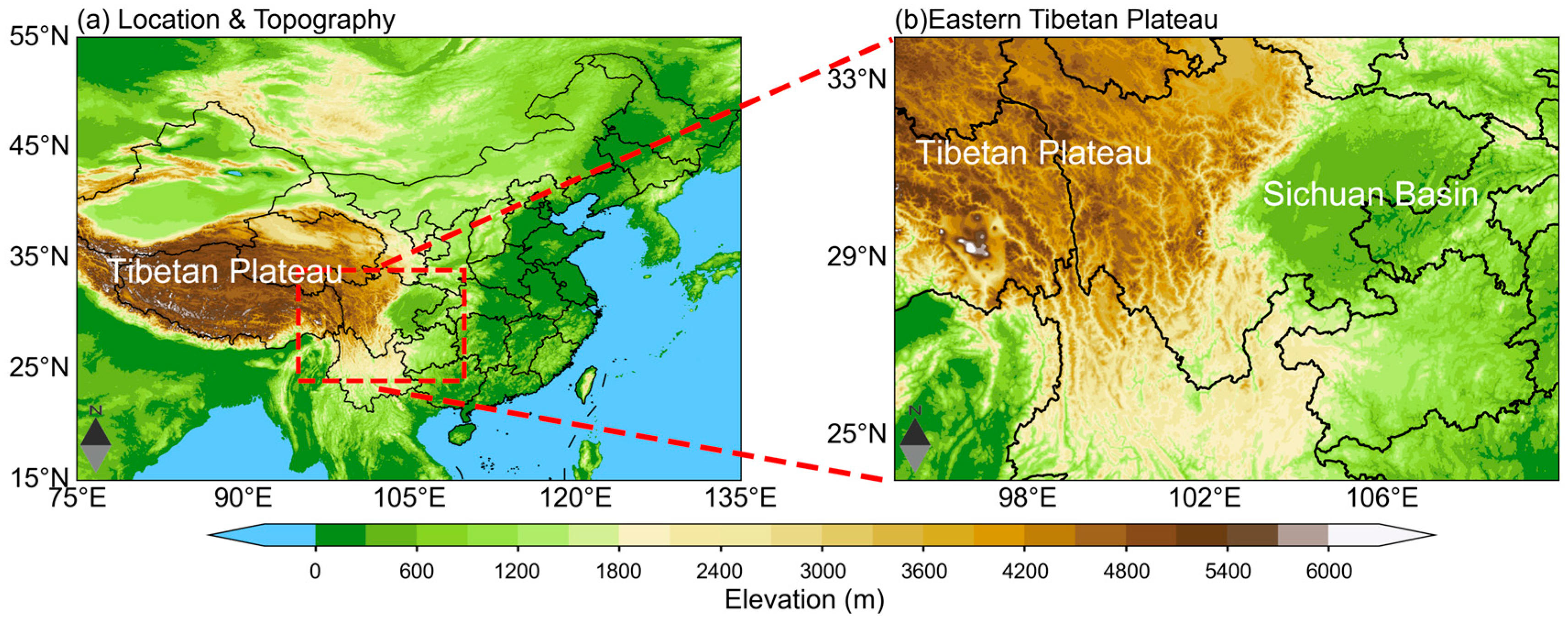
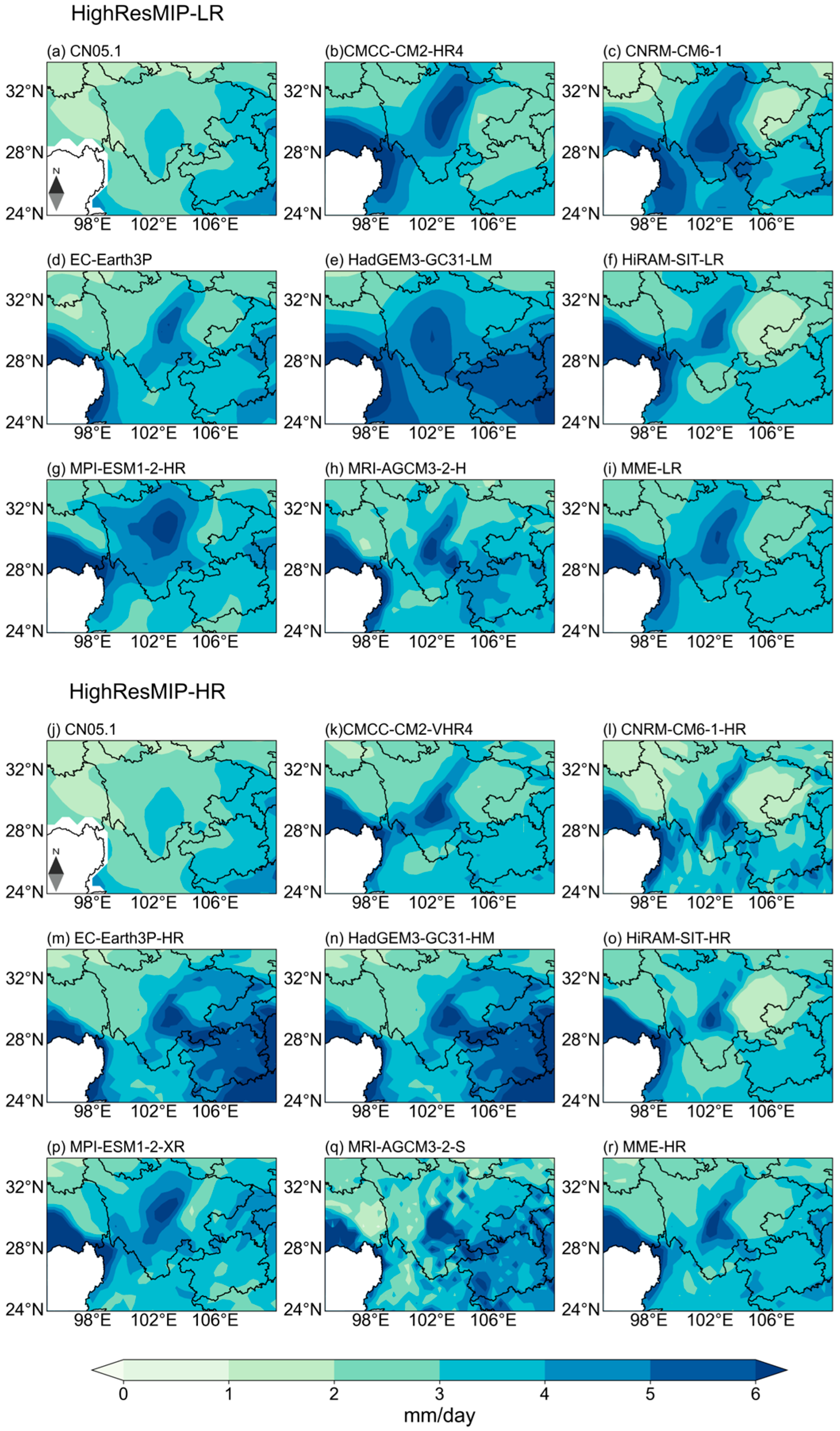
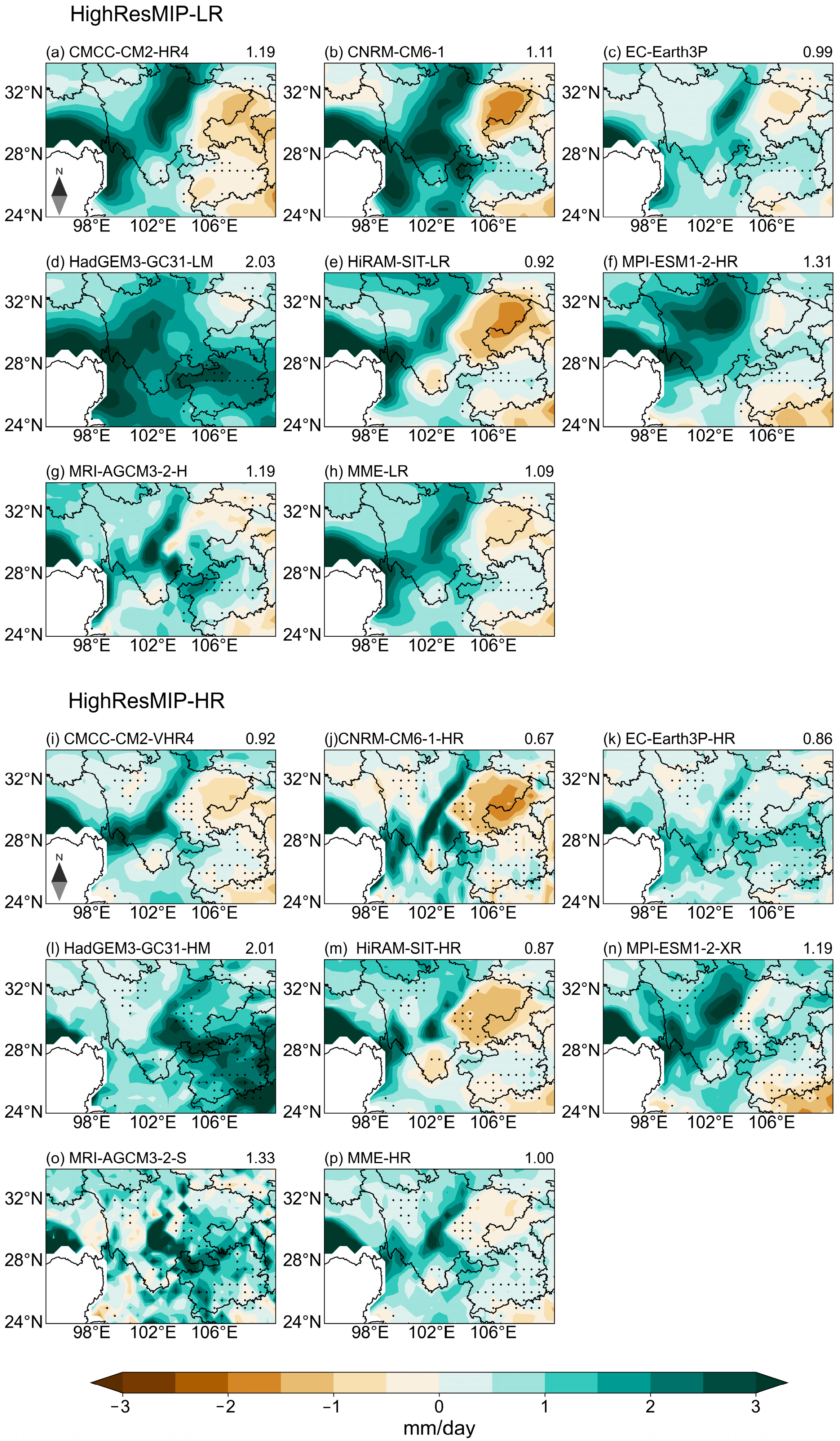


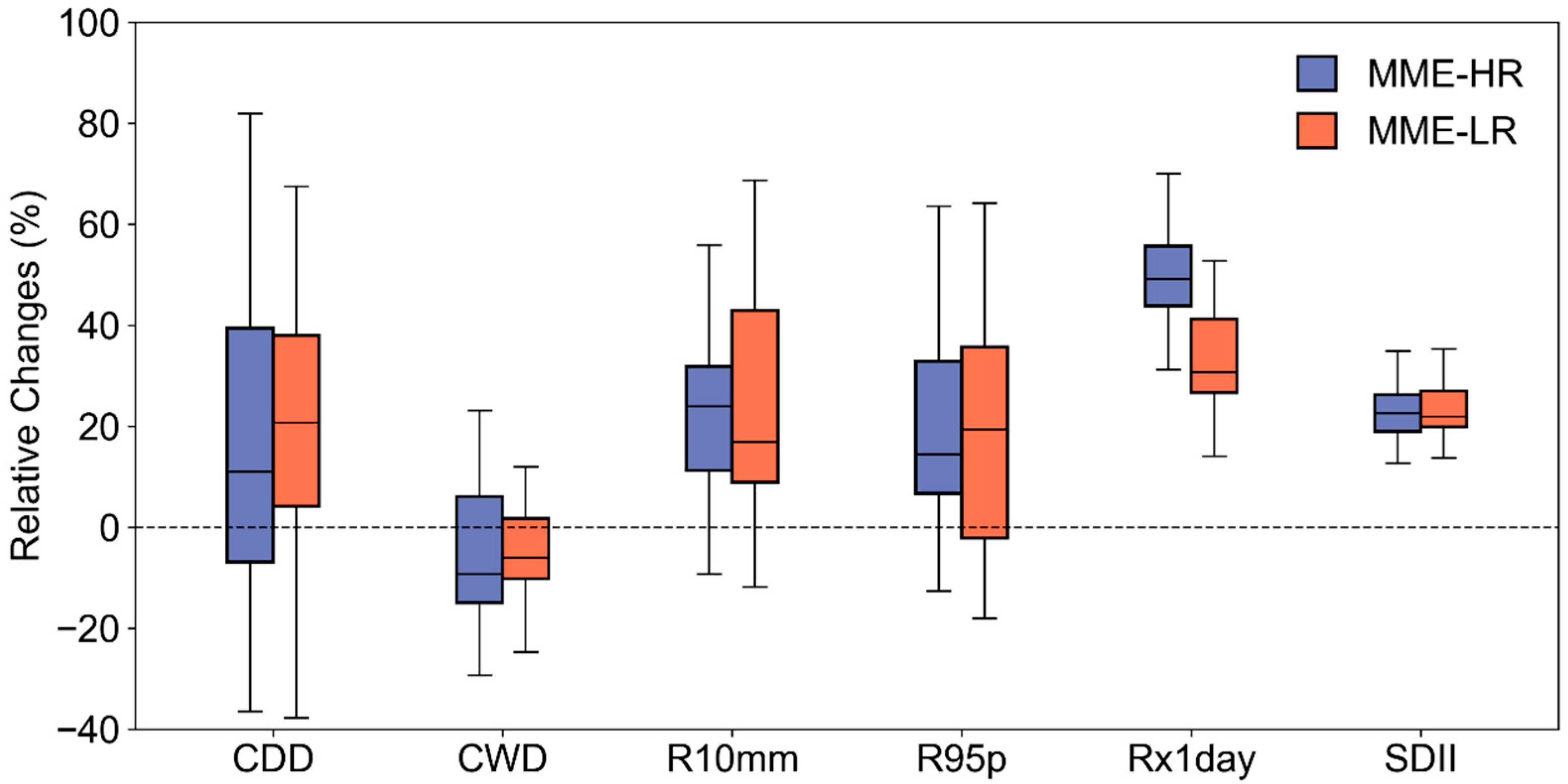
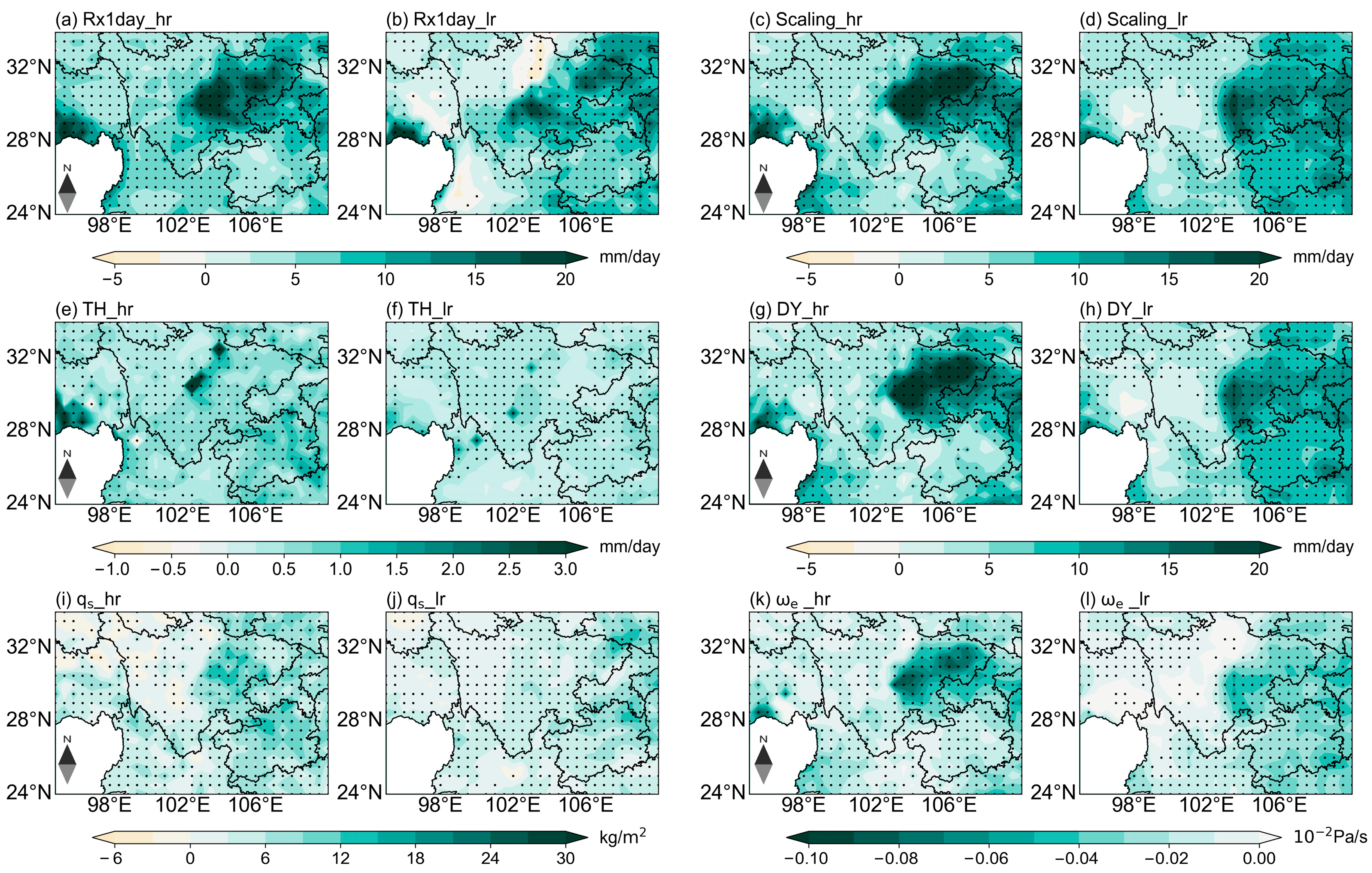

| Model | Institution | Country/Region | Horizontal Resolution (lon. × lat.) |
|---|---|---|---|
| CMCC-CM2-HR4 | Euro-Mediterranean Centre on Climate Change (CMCC) | Italy | 1.25° × 0.94° |
| CMCC-CM2-VHR4 | 0.31° × 0.23° | ||
| CNRM-CM6-1 | National Centre for Meteorological Research | France | 1.40° × 1.40° |
| CNRM-CM6-1-HR | 0.50° × 0.50° | ||
| EC-Earth3P | EC-EARTH consortium | Europe | 0.35° × 0.35° |
| EC-Earth3P-HR | 0.70° × 0.89° | ||
| HadGEM3-GC31-MM | Met Office Hadley Centre (MOHC) | United Kingdom | 0.56° × 0.83° |
| HadGEM3-GC31-HM | 0.23° × 0.35° | ||
| HiRAM-SIT-LR | Geophysical Fluid Dynamics Laboratory | America | 0.50° × 0.50° |
| HiRAM-SIT-HR | 0.23° × 0.23° | ||
| MPI-ESM1-2-XR | Max Planck Institute for Meteorology (MPI-M) | Germany | 0.47° × 0.47° |
| MPI-ESM1-2-HR | 0.94° × 0.94° | ||
| MRI-AGCM3-2-S | Meteorological Research Institute (MRI) | Japan | 0.19° × 0.19° |
| MRI-AGCM3-2-H | 0.56° × 0.56° |
| Index | Description | Definition | Units |
|---|---|---|---|
| CDD | Consecutive dry days | Maximum number of consecutive days with PRCP(Precipitation) < 1 mm | days |
| CWD | Consecutive wet days | Maximum number of consecutive days with PRCP ≥ 1 mm | days |
| R10mm | Heavy precipitation days | Annual count of days when PRCP ≥ 10 mm | days |
| R95p | Extreme rainfall at the 95th percentile | 95th percentile of precipitation in the analyzed period | mm |
| Rx1day | Maximum 1-day precipitation | Maximum of 1 day of precipitation amount | mm |
| SDII | Simple daily intensity index | Total wet day precipitation divided by number of rainy days | mm/day |
Disclaimer/Publisher’s Note: The statements, opinions and data contained in all publications are solely those of the individual author(s) and contributor(s) and not of MDPI and/or the editor(s). MDPI and/or the editor(s) disclaim responsibility for any injury to people or property resulting from any ideas, methods, instructions or products referred to in the content. |
© 2025 by the authors. Licensee MDPI, Basel, Switzerland. This article is an open access article distributed under the terms and conditions of the Creative Commons Attribution (CC BY) license (https://creativecommons.org/licenses/by/4.0/).
Share and Cite
Liu, X.; Liu, X.; Li, C.; Ma, X.; Chen, K.; Sun, Z.; Wang, K.; Chen, Q.; Cai, H. Projections of Extreme Precipitation Changes over the Eastern Tibetan Plateau: Exploring Thermodynamic and Dynamic Contributions. Atmosphere 2025, 16, 664. https://doi.org/10.3390/atmos16060664
Liu X, Liu X, Li C, Ma X, Chen K, Sun Z, Wang K, Chen Q, Cai H. Projections of Extreme Precipitation Changes over the Eastern Tibetan Plateau: Exploring Thermodynamic and Dynamic Contributions. Atmosphere. 2025; 16(6):664. https://doi.org/10.3390/atmos16060664
Chicago/Turabian StyleLiu, Xiaojiang, Xi Liu, Chengxin Li, Xiaomin Ma, Kena Chen, Zhenhong Sun, Kangning Wang, Quanliang Chen, and Hongke Cai. 2025. "Projections of Extreme Precipitation Changes over the Eastern Tibetan Plateau: Exploring Thermodynamic and Dynamic Contributions" Atmosphere 16, no. 6: 664. https://doi.org/10.3390/atmos16060664
APA StyleLiu, X., Liu, X., Li, C., Ma, X., Chen, K., Sun, Z., Wang, K., Chen, Q., & Cai, H. (2025). Projections of Extreme Precipitation Changes over the Eastern Tibetan Plateau: Exploring Thermodynamic and Dynamic Contributions. Atmosphere, 16(6), 664. https://doi.org/10.3390/atmos16060664






